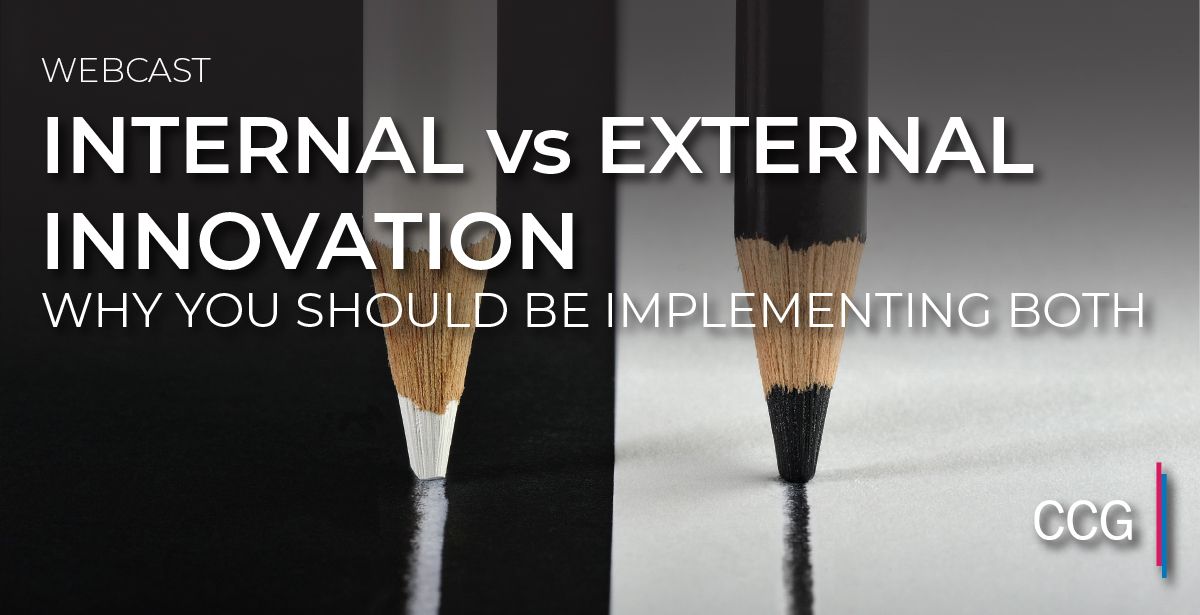Available On Demand – 19 minutes
Innovation continues to be an integral part of the financial services industry but how much time should be spent focusing on internal innovation vs exploring innovation opportunities with outside parties like fintech startups? Join the CCG team with host Emily Lockwood as she sits down with CCG’s Managing Director and Chief Strategy and Innovation Officer Scarlett Sieber to explore both the internal and external sides of innovation and why it makes sense to incorporate both into your strategy moving forward.
Subscribe to CCG Insights.
[restrict]
Emily Lockwood Hey, everyone, welcome back to the CCG Webcast. I’m Emily Lockwood, your host and Marketing Communications Consultant at CCG. I’m joined today by Scarlett Sieber, our Managing Director and Chief Strategy and Innovation Officer at CCG Catalyst. Hey, Scarlett, how are you today?
Scarlett Sieber Hey, Emily. Doing well. Happy to be here. Talking about the topics that I love, innovation.
Emily Lockwood Great. OK. So today we’re going to dig a little deeper into what innovation really means and focus on the internal and external sides of innovation. But before we get into all of that, I do have some housekeeping items for you. I know that those of you have joined have probably heard me say this before. But for those of you that don’t know, if you look at below Scarlett and I’s faces, you’ll see our headshots. If you click on that it’ll show you our bios, our LinkedIn and Twitter. You can connect with us from there. You’ll also see CCG logo. Now, this will give you really great access to our insights. You can see recent articles and blogs. It also kind of give you a perspective on what we’ve been focusing on lately. And then also you will see the Q and A button. This is a really great way for you guys to ask us questions during the webcast. We’ll do our best to answer them live. But if we don’t get to you during the webcast, we’ll be sure to reach out to you and answer those questions for you relatively soon. And then also there is the Twitter icon. This is also a really great way to keep up with CCG is up to our Twitter account is updated daily. We usually push out several posts a day, so there’s plenty for you to see there. So with that, let’s dive into our topic. So, Scarlett, our first question is, as far as innovation, how would you define internal and external innovation for banks?
Scarlett Sieber Yeah, Emily, it’s a good question. It’s nice to kind of set the stage because innovation means so many different things to so many different people and we talked a little bit about that last time. Really, the difference between internal and external is actually quite simple. So internal is really about utilizing and leveraging existing capabilities and resources and your assets. So it’s taking advantage of your team. So usually when you’re talking about internal innovation initiatives that’s things that you’re doing at the company, inside the company with existing team members. And it’s a great place to just leverage the best capabilities and intelligence of your colleagues and of your team members. Whereas external is looking outside of the firm, and it’s really about taking advantage of external capabilities. There might be areas that are not part of your core competency, that people are doing things really, really well. So you’re taking advantage of that. You’re partnering with those people. And it’s really about looking at and utilizing the best capabilities outside of your organization with minimal investment and internal resources on the firm side.
Emily Lockwood OK. So let’s dive a little bit deeper into the internal innovation. What are some advantages of that? And why would a bank want to focus on their internal innovation strategy?
Scarlett Sieber Yeah, I don’t think that you can talk about something like internal innovation without getting into culture, which we’ve had over on the webcast. One of our colleagues, John Macaluso, certainly likes to make references to culture. And a lot of the strategy things that we talk about, whether it be payments or Oyo or whatever else you’re looking at, but it’s certainly lives and is really true with internal innovation. And really why it would make sense to probably start here is to do things like innovation, to really build out that digital capability and components. You need to have the right culture in place. And so internal innovation is a great place to start building that innovative culture and really embedding it into the DNA of the firm. And some banks have an approach where when they think about it, maybe innovation is one of their core pillars or values for who they are and what represents them. And, you know, in some cases, they like to say that innovation is something that every employee is evaluated on and everyone should be living, breathing and doing, which is nice because it really is a good job. It does a good job of exemplifying the idea of we all believe in this innovative mindset. I mentioned this a little bit, but it really is about leveraging the intelligence of your organization and what’s powerful there is especially the larger that we get, even with when we have a few hundred employees or maybe a few dozen employees, they are typically hired for a very specific job. But they might have other capabilities or ideas that are not typically shared that through something like pushing internal innovation forward, you start seeing these new ideas and new ways of thinking. And you’re actually getting more from your employees then you were when you have them in a very siloed, specific role, they might have thoughts in their daily lives and interactions that actually has them thinking about things slightly differently. And really it’s benefits of different perspectives even within your organization. I would say this is getting a little bit into H.R. But I think one of the biggest impacts of internal innovation is action on the H.R. component. Part of it is hiring younger generations. There’s plenty of stats around that. And I’ve gone to so many conferences where we focus on millennials and now we’re looking even at GenZ. But these younger generations want to feel empowered and excited about what it is they’re doing. And when you start pushing things like internal innovation where they can have a direct role and impact in the future of your company, you’re building that sense of ownership and empowerment that really ties to passion and productivity, which I think is really powerful. And of course, so the response to that is bringing in talent that maybe was not interested in going to a bank before. Maybe they were interested in the tech companies or whatever else. But through that now they feel empowered and excited. So you’re bringing in talent that wouldn’t come before and you’re retaining people in a way that maybe you haven’t before. So I would say those are the key things. The last being, if you get really good at this and you’ve definitely seen examples of this on the bigger financial institutions, and I’m sure there are examples in the smaller ones as well. But once you start to do this really, really well and it becomes automated and systematized, there’s a lot of potential for building IP here, which can have great, great benefits for many reasons.
Emily Lockwood OK. So knowing all of that and looking at the different opportunities for internal innovation, what are some things that banks can do to really start this process?
Scarlett Sieber It’s a big undertaking. So there are things that when people talk about internal innovation in the press and things like that, you’ll hear things, especially from the bigger banks, about building out an entire internal incubator where you’re ideating and bringing ideas into house and even creating startups in house. So you get that lab component there, which is a big, big investment. Both in terms of talent, the actual infrastructure, everything else, budget, you name it. And then, of course, one other thing that’s typically associated with kind of this internal innovation and it’s become more and more popular and I’ve seen this go downstream to the smaller financial situations is the idea of creating a venture fund or at least investing in startups, but using those resources internally to take advantage of that, where you have your own fund, where you’re spending a lot of time looking at deals. So that’s what typically people think of when they talk about that. There are actually a lot of things that you can do to get started that is way less work than what I just talked about. One of the most basic ones, I would say, with a very minimal effort is doing things like putting together a C suite brief or at the board meetings, having innovation be integrated and part of those updates, associated updates on a quarterly basis, on a yearly basis, where you bring in industry experts, experts in innovation, experts in fintech, expert in all these new things to really talk about what is happening. Even if you as a firm are to early on to feel like, hey, we’re not ready to do this ourselves, it’s still important to stay abreast of and aware of what’s actually happening. So that’s a great way to just get started on and getting everyone engaged, especially at the C Suite level from an understanding perspective and at the board level as well. You can then do the next level deeper which is really around a line of business level and have brainstorms around there on how can they innovate, how can they improve on their existing processes? Because it’s really easy. It’s natural. And I’ll speak from experience because I’ve been on the other side doing this where we have such a long list of things and priorities and meeting shareholder expectations that we get very caught up in our daily lives and like checking off the boxes. It’s important to take that step back and really think through what are the opportunities, what could we be doing? Let’s not just stay above water now or get around this pillar now, but what is the race three to five years from now look like? And what can we be doing to day to set ourselves up for success there? Then you can of course, we talked a little bit about the empowering of the of the group and of the collective mind and so that you can do some things around and internal calls for ideas with your employees at large, putting together some type of cash prizes around that or not. It doesn’t have to be money because there’s a lot that goes into that which we don’t want to go into right now. But even just, hey, you win and you get to present in front of the C suite. There’s a lot of things you can do to kind of get people excited, get them engaged. And then the other piece, I would say this takes a little bit more work maybe than the first. But is the idea of most of us have an employee intranet, you know, a site that we all use where we engage with each other at these financial institutions. And so using that as a platform to help tell the stories and ideas of different people within the organization and maybe even what the different roles and responsibilities are, because, you know, again, it’s so easy to get siloed and caught up in all levels, but definitely more at the junior level of the organization of what it is you’re doing without really understanding the impact that that has at the company at large. So if there could be some type of a skill sharing podcast, I think that could be it doesn’t have to be a podcast, which is kind of the thing right now. But just somehow that you are showcasing the unique skills and assets of your team members in ways that you haven’t before could be super helpful.
Emily Lockwood So what about after looking internally and how we can be innovative, what about externally? What can beings do to kind of focus on external innovation and what are the advantages of it?
Scarlett Sieber Yes. So why would they want to be looking externally? If I had a hat, I would put it to the other side now because often times people start with the internal which is a good place to start. Like I said, especially from embedding that culture and that way of thinking and putting processes together. I do believe, though, that especially within financial services and this is true across industries, but definitely within financial services, that we get caught up in the idea that we need to build that ourselves and that a lot of time that ends up resulting in kind of reinventing the wheel. And so if you start looking at opportunities on the external side, there’s a lot of inspiration and motivation there that we get caught up in our day to day stuff that you all of a sudden are thinking about the things we’ve been thinking about, both for a very different perspective. That’s actually extremely helpful. So at minimum, being inspired and motivated and kind of tracking what’s happening the same way that we talked about bringing external people into the C Suite meetings, but doing this at a more ongoing and consistent basis and kind of see where the industry is going and how we want to react. Definitely learnings. One thing, too, is an advantage of looking at what’s happening outside is you aren’t necessarily the one who’s having to put those heavy investments into testing out new things. But you can kind of see from afar how well things are working and how things aren’t working. And it’s a good level set engaged to see. Are we thinking about things the correct ways? Are we measuring success in the right ways? And I mean, really, we have this whole other series around bank and bank fintech partnerships and spoiler alert, I’m all for them. Definitely pro fintech and pro collaboration. But with the idea of the external ecosystem, external partnerships, you are leveraging each other’s best capabilities. There’s things that banks do super well and there’s things that fintech and others do super well and you’re taking advantage of that. And together you have this synergistic, beautiful relationship and you don’t have to reinvent the wheel.
Emily Lockwood So what does the external innovation ecosystem look like and how can banks get involved?
Scarlett Sieber Well, I like to make sure that I offer the lowest barrier of entry first. So you know, we’re a little bit of a different world right now in 2020, but meet ups those are moving online, too. So just kind of awareness. I would say is the quickest and easiest way. But there’s ways to do that. Where you’re actively engaging and meet ups is a really good place to start. There are fintech meet ups. There are small business meet up, their payment meet ups, you name it. Just playing an active role there. And that’s for anyone one of the organizations. Definitely encouraging for the C Suite but even your more junior team members may be having them go on your behalf to gather information and collect data to come share with you. Of course, there are is the accelerator model. There is different levels of involvement there. But at the most basic level, getting involved as a mentor, providing feedback to these aspiring entrepreneurs and understanding how they’re thinking and providing your expertise and insight from the banking side I think is super crucial. And just attending Demo Day. So you’re getting an idea of what’s happening is pretty powerful. One thing that I think is kind of under utilized but it is becoming more common even within financial services is the idea of connecting with other incumbents and your peers and talking about and thinking about, the credit unions definitely do a better job of this just because there they’ve always been a little bit more communal in nature there, but connecting with your peers and the other incumbents about what’s actually happening. So maybe having an ongoing recruiting meeting or brainstorm around specific topics about how are you thinking about this? OK. So now let’s talk about bank fintech partnerships. What are the hurdles that you’re seeing without getting to anything that’s, you know, that you can’t disclose. But at a high enough level, here is the kind of problems running into here’s how we’re thinking about solving. Them together as an industry that helps all which I think is really powerful. And then, you know, outside of that, just taking advantage of and building relationships with venture capitalists at the local level. There’s been a lot of money in the space, especially in fintech over the years. And so of course, you think of the big markets with that. But those are also true in small markets. So establishing relationships there, they’re going to want to know you because you could be potential clients for their portfolio companies. And from that, you can get a ton of information. How are they thinking about investment? Why are these companies, the ones are standing out? Why do they think these ones are going to be the one for the future? Because, of course, their goal is financial returns. Universities as well. That’s a great place to be engaged. You got young minds who are super excited about the future, who are thinking about things, who a lot of them are starting companies while they’re in school. And if that doesn’t work out, you still have that opportunity to then use that as a pipeline for hiring as well. So I’d say those are some of the good places to get started. In terms of bigger investments, you could go and actually work out of one of these coworking spaces. And of course, it’s a little bit different now with the world of Corona. But I do believe that that we will get back to a sense of normalcy eventually. So it’s not uncommon for incumbents to have a space, even just a few desks inside of this coworking environment to get the culture, to get the feel and to get to be surrounded by those ideas. And you can even have it where it be a hot desk. And it’s not the same people working in that space every time, but they’re moving around, which could be really interesting. And, yeah, there’s a lot you could do on the big investment side. But let’s keep it on the kind of immediate stuff for now. I think.
Emily Lockwood Thanks, Scarlett. It sounds like there’s a lot of opportunity on the internal and external sides of innovation for banks. CCG can provide fintech partnership strategies for you. As you can tell, Scarlet’s really passionate about this topic and so is the rest of the CCG team.
Scarlett Sieber Absolutely. And we’ve certainly have experience doing this with banks on an international level. I’ve done this myself at three different sizes of financial institutions, big, small, global, regional. And it’s a big under task and one that you want to think thoroughly through before getting started. But it is a lot of fun. I can promise you that.
Emily Lockwood Good to know. So thanks again for tuning in. We know you guys are really busy. Again, we will respond to your questions if we did not get to them today. And we’ll see you at the next CCG webcast. Have a great rest of your day.
Scarlett Sieber Thanks, Emily.
[/restrict]
Business Continuity: Unlocking Digital Commercial Banking Capabilities
Financial Brand Article: Over the COVID Horizon, Mobile Banking Demands Strategic Clarity
Digital Dreams – Expanding Commercial Banking Capabilities
Financial Brand Article: Is It Finally Time for Open Banking’s Debut in America?

Chief Strategy & Innovation Officer Scarlett Sieber is one of the world’s premier voices in financial services. She is among the industry’s most sought-after speakers as a thought leader and innovator with expertise in driving organizational change at both startups and enterprises across the financial services and fintech ecosystem. Scarlett has been invited to speak at over 100 prestigious financial services and technology conferences globally, including Money20/20, Finovate, South Summit, and NASA’s Cross Industry Innovation Summit.
Scarlett’s experience includes founding her own startup as well as working at banks such as BBVA, USAA, and Opus Bank. She is a leading fintech influencer, included on lists such as Top 100 Women in Fintech 2019 and Top 10 Fintech Influencers in the U.S. Scarlett also has deep experience in digital strategy and innovation implementation, making her a key asset to building cutting-edge programs for our clients.

Emily Lockwood is the Marketing Communications Consultant for CCG Catalyst. Her experience in communication and public relations enables her to implement creative strategies for clients that create public and media awareness. She is skilled in strategic planning, social media, event planning and pitching. Her professional experience includes writing for the Arizona Republic, managing social media for the NFL, and creating campaigns for FOX Broadcasting and NBC Universal. She also has extensive agency experience and has worked for a range of clients including hospitality, real estate and healthcare.






